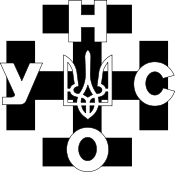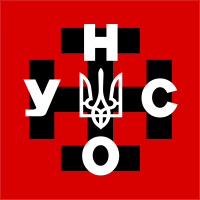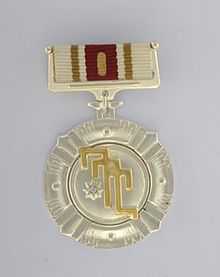Ukrainian National Assembly – Ukrainian People's Self-Defence
| Ukrainian National Assembly | |
|---|---|
 | |
| Founded | 3/4 November 1990 |
| Dissolved | 22 May 2014[1] (Political wing only.[1]) |
| Merged into | Right Sector[1] (Political wing only.[1]) |
| Headquarters | Kiev |
| Membership (2006) | 8,000[2] |
| Ideology | Ukrainian nationalism |
| Political position | Far-right[3][4] |
| International affiliation | None |
| Colours | Red, black |
| Party flag | |
 | |
| Website | |
|
una-unso | |
|
Politics of Ukraine Political parties Elections | |
The Ukrainian National Assembly – Ukrainian People's Self-Defence (Ukrainian: Українська Національна Асамблея-Українська Народна Самооборона , УНА-УНСО, UNA-UNSO) is a Ukrainian political organisation. The UNA-UNSO is often perceived as far-right in Ukraine and abroad.[5][6]
The Ukrainian National Assembly (Ukrainian: УНА, UNA) acted as the organisation's legal political-wing, but on 22 May 2014 this merged into Right Sector,[1] while UNA-UNSO continues to operate independently.
According to Andreas Umland and Anton Shekhovtsov, the UNSD was created in 1991 as a "formation manned by UNA members who had served in the Soviet armed forces" "to confront the State Committee for the State of Emergency".[7]
History
First years
Ukrainian National Assembly (UNA) was created on 30 June 1990 in Lviv under the name of Ukrainian Inter-party Assembly (UMA).[8] It was led by a maverick politician and nationalist writer Dmytro Korchynskyy. On 3–4 November 1990 a constituent congress of the Ukrainian National Association (UNS) took place in Kiev. On 11 January 1991 squads of UNS headed by Yuriy Tyma guarded the Seimas Palace during the January Events in Lithuania when the Soviet Union invaded Lithuania. On 30 June 1991 some 200 members of UNS conducted a torch parade to commemorate the Declaration of Ukrainian Independence in Lviv 1941.
In the first days of the 1991 Soviet coup d'état attempt a squad of UNS led by the Vietnam War veteran Valeriy Bobrovych departed to Moscow. Later that squad laid foundation in creating the "Argo" battalion. On 19 August 1991 in the fight against the State Committee on the State of Emergency, UNS created squads of the Ukrainian People's Self-Defense (UNSO) in Kiev. The squads were formed around a small group of ethnically Ukrainian Soviet army veterans who fought in Afghanistan (see Soviet war in Afghanistan). In December 1990 as first head of UNS was elected Yuriy-Bohdan Shukhevych, a son of Roman Shukhevych.[8] Because of the 1991 Declaration of Independence of Ukraine on 8 September 1991 the 6th session of Ukrainian Inter-party Assembly was officially renamed as the Ukrainian National Assembly, while among people it became known as UNA-UNSO due to the UNSO close association with UNA.[8]
Since gaining its independence in 1991 Ukraine chronically suffers from separatists movements directed to reunite some of the Ukrainian territories with Russia and other neighbouring countries. UNA-UNSO managed to stop enthusiastic activities of a People's Deputy of the Supreme Soviet of the Soviet Union Goncharov in Donets basin in reestablishing the Donetsk-Krivoy Rog Soviet Republic and its Donetsk National Guard. In Kiev was liquidated an organisation "Patriotic forum" (Otyechestvyennyi forum). In November 1991 UNSO disperse their congress and rally. Due to the brawl involving UNSO fighters the government conducted the first mass arrests against UNSO activists. In Odessa UNSO stopped an initiative in creation of the "Novorossiysk Republic" which also influenced another separatists movements in Bukovina and Zakarpattia. On 7 June 1992 a Lviv team of UNSO dispersed the Romanian congress in Chernivtsi which was provoking in uniting of the Northern Bukovina with Romania.
Early 1993 reportedly Ukrainian People's Self-Defense (UNSO) had 4,000 members.[8]
Crimea
Since 1991 and to this day on the territory of Ukraine, Crimea and Sevastopol, are located forces of the Russian Federation, which explicitly contradict the Constitution of Ukraine. In 1991 on the territory of Ukraine were located the Russian Black Sea Fleet and the 126th Division of Coastal Defense subordinated to Moscow commanded by the Russian admiral Igor Kasatonov. Admiral Kasatonov sharply reacted to all pro-Ukrainian actions of sailors such as labelling them traitors, hounded or discharging from Navy the officers who were sworn allegiance to Ukraine. When in April 1992 headquarters officers of the Naval base in Novo-ozerne were sworn allegiance to the Ukrainian state, he ordered to block the base with armoured tanks from the coast and with military ships from the sea. Kasatonov refused to execute any orders of the President of Ukraine and declarations of the Verkhovna Rada of Crimea. In Crimea over the official buildings were flying the official flags of the Soviet Union, openly acted militarised organizations of local Cossacks and other patriotic clubs.
Because of no laws of Ukraine seemed to be possible to enforce in Crimea, UNA-UNSO decided to conduct a series of crusade marches and prayers for the perished Ukrainians in Odessa, Kherson, and Sevastopol. In the campaign have agreed to participate priests of the Ukrainian Autocephalous Orthodox Church (UAPC) and the Kiev choir "Homin".
History since 1994
UNA was officially registered as a political party in December 1994[8] and during Ukrainian parliamentary election in 1994 three UNA-UNSO members were elected as deputies of Verkhovna Rada (Ukrainian parliament). in September 1995 its registration was rescinded and its registration was not renewed till 1997.[8]
UNSO was registered only (as a public organization) in Lviv oblast, Ternopil oblast, Rivne oblast and Poltava Oblast; and never on a national level.[8] In practise however there was no distinguishing between members of both organizations.[8]
Between 1994 and 1997 UNA-UNSO members gained prominence in Ukraine through a number of anti-Russian actions. UNA-UNSO deputies destroyed a Russian flag in Ukrainian parliament, UNA-UNSO fighters joined the Chechen rebels in First Chechen War and fought against the Russian army, its activists organised street protests against Russian pop-stars visiting Ukraine. UNA-UNSO took sides in Ukrainian church affairs and in July 1995 clashed with police during the funeral of Patriarch Volodomyr, head of Ukrainian Orthodox Church - Kiev Patriarchate. UNA-UNSO supported Patriarch Filaret (Mykhailo Denysenko) excommunicated by the Russian Orthodox Church, and participated in violent attempts to capture church property for the new church, notably in Rivne and Volyn oblasts. Membership of the organisation peaked at around 10 000 members, who were mostly young Ukrainians. About 90% of its members were between 18 and 35 years old.
The organisation was depicted in Georgy Gongadze's 1994 documentary film "Shadows of War".
In 1997 government of Leonid Kuchma banned the Ukrainian National Assembly – Ukrainian National Self Defence. Members of UNA-UNSO responded with a number of violent street protests, resulted in over 250 arrests. Dmytro Korchynskyy himself was arrested and soon after left the ranks of UNA-UNSO.
In 1998 UNA-UNSO new leaders of the organisations became Andriy Shkil and Yuriy Shukhevych, son of prominent Ukrainian nationalist Roman Shukhevych.
UNA-UNSO participated in Ukrainian parliamentary election of 1998 but managed to get only 0.39% of the votes.[9]
In 2000 and 2001 members of Ukrainian National Assembly – Ukrainian Nationalistic Self Defense actively participated in Ukraine without Kuchma mass protest campaign.
During the 2002 parliamentary elections Andriy Shkil won a single-mandate constituency in the Lviv Oblast (province) and thus a seat in the Verkhovna Rada,[10][11] the party itself won 0.04% of the votes.[9] In 2003 Shkil left the party,[12] he has become a close aide to influential politician Yuliya Tymoshenko.[13][14]
During Orange Revolution, UNA-UNSO members supported Viktor Yushchenko against his pro-Russian opponents. UNA-UNSO members provided security for the supporters of Viktor Yushchenko, and prominent leaders of the Orange camp such as Yulia Tymoshenko on Independence Square in Kiev.[15]

In 2005 Yuriy Shukhevych became the leader of the party again. In the 2006 parliamentary elections the party failed to win parliamentary representation with 0.06% of the votes.[9] The party did not participate in the 2007 elections.[9]
In 2008, the South Ossetian Prosecutor General Teimuraz Khugayev accused UNA-UNSO to have participated with a unit on the Georgian side during the August war. But so far no evidence of this has been provided.[16] According to a Russian Investigative Committee report from August 2009, 200 members of the Ukrainian UNA-UNSO as well as full-time servicemen of the Ukrainian army aided Georgian forces during the fighting; Ukraine denied the accusation. UNA-UNSO deputy head Nikolay Karpyuk said that "unfortunately," no members of the organisation took part in the fighting in Georgia.[17]
The party did again participate in the 2012 Ukrainian parliamentary election.[18] In these elections the party won 0.08% of the national votes and no constituencies (it had competed in 5 constituencies[19]) and thus failed to win parliamentary representation.[20]
In March 2014, Russia launched a criminal case against the party, and some members (including party leader Oleh Tyahnybok) of Svoboda, for "organizing an armed gang" that had allegedly fought against the Russian 76th Guards Air Assault Division in the First Chechen War.[21]
The political-wing Ukrainian National Assembly merged into Right Sector on 22 May 2014.[1]
International Conflicts
- January Events in Lithuania (Winter 1991)
- 1991 Soviet coup d'état attempt in Moscow (Summer 1991)
- War of Transnistria in Moldova (Spring-Summer 1992)
- War in Abkhazia (1992–1993)
- Chechen War in Russia (1995-1996)
- Kosovo War in Yugoslavia (1998-1999)
Transnistria

In the War of Transnistria members of UNA-UNSO fought on the side of Transnistrian separatists against Moldovan government forces.[22] This was justified as a defence of large ethnic Ukrainian minority in Transnistria.[8] Over 50 members of UNSO were awarded order "Defender of Transnistria".
In the spring of 1992 700 members of UNSO participated in extinguishing a pro-Russian separatist movement in Crimea. In autumn of 1992 a similar movement was extinguished in Zakarpattia. Concurrently with that UNSO sponsored a return of the Ukrainian veterans from across the Soviet Union.
Georgia civil war
In 1993 UNA-UNSO sent volunteers to participate in Georgian-Abkhaz conflict in fight against the Abkhasian separatists.[23][24] UNA-UNSO fighters formed a unit called "Argo" and joined Georgian side against Russian-backed Abkhaz forces. Some volunteers joined the Sukhumi Battalion of the Marine Infantry Forces of Georgia. A squad of CPT Ustym prevented an amphibious assault of Russian forces near Sukhumi and sank a Russian military motorboat. Seven members of UNSO perished during the conflict near Sukhumi, 30 members were awarded the order of "Vakhtang Gorgasali".
- Sukhumi raid (June 1993)
- Starushkino village ambush (15 July 1993)
- Shromi village assault (17 July 1993)
- Khomi defence (4 October 1993)
- Samtredia defence (17 October 1993)
Ideology and image
Ukrainian National Assembly – Ukrainian People's Self-Defence 1994 party program envisioned Kiev as the centre of a new Pan-Slavic eastern Slavic military bloc.[8]
International security expert Andrew Mcgregor has stated (in 2006) that the UNA-UNSO "might be best characterized as an influential fringe movement", and that "its high visibility belies its limited numbers".[2]
UNA-UNSO has an anthem, which is called 'Stay, my love, don't cry, honey'. It is a remake of the Bella Ciao song.[25]
Elections
| Parliamentary since 1994 (year links to election page) | ||||||||
|---|---|---|---|---|---|---|---|---|
| Year | Votes | % | Mandates | |||||
| 1994 | |
|
| |||||
| 1998 | |
|
| |||||
| 2002 | |
|
| |||||
| 2006 | |
|
| |||||
| 2007 | |
|
| |||||
| 2012 | |
|
| |||||
UNA-UNSO parliamentarians
- Yuriy Tyma
- Andriy Shkil
See also
References
- ↑ 1.0 1.1 1.2 1.3 1.4 1.5 Right Sector registered as official party, Interfax-Ukraine (22 May 2014)
- ↑ 2.0 2.1 McGregor, Andrew (30 March 2006), [tt_news=31539 Radical Ukrainian Nationalism and the War in Chechnya], The Jamestown Foundation
- ↑ Wilson, Andrew (2005), Ukraine's Orange Revolution, Yale University Press, p. x
- ↑ Ramet, Sabrina P. (1998), Nihil Obstat: Religion, Politics, and Social Change in East-Central Europe and Russia, Duke University Press, p. 257
- ↑ Singh, Anita Inder (2001), Democracy, Ethnic Diversity, and Security in Post-Communist Europe, Greenwood, p. 114
- ↑ Dymerskaya-Tsigelman, Liudmila; Finberg, Leonid (1999), "Antisemitism of the Ukrainian Radical Nationalists: Ideology and Policy", Analysis of Current Trends in Antisemitism (Vidal Sassoon International Center for the Study of Antisemitism) (14)
- ↑ Umland, Andreas; Shekhovtsov, Anton (September–October 2013). "Ultraright Party Politics in Post-Soviet Ukraine and the Puzzle of the Electoral Marginalism of Ukrainian Ultranationalists in 1994–2009". Russian Politics and Law 51 (5): 33–58. doi:10.2753/RUP1061-1940510502.
- ↑ 8.0 8.1 8.2 8.3 8.4 8.5 8.6 8.7 8.8 8.9 The radical right in Central and Eastern Europe since 1989 by Sabrina Ramet, Pennsylvania University Press. 1999 ISBN 0-271-01810-0 (page 290 and continuing from there)
- ↑ 9.0 9.1 9.2 9.3 (Ukrainian) Українська національна Ассамблея, Database DATA
- ↑ The Constituency № 121, Central Election Commission of Ukraine (2002 regular election)
- ↑ Results of voting in single-mandate constituencies, Central Election Commission of Ukraine (2002 regular election)
- ↑ "A brief course of UNA-UNSO history UNA-UNSO :: Articles". Retrieved 3 March 2015.
- ↑ Yulia Tymoshenko’s orbits / Ukrayinska Pravda
- ↑ The Makeup of the New Verkhovna Rada / Ukrayinska Pravda
- ↑ Far-right Group Flexes During Ukraine "Revolution", Associated Press, 1 January 2005]
- ↑ Allenova, Olga (25 November 2008). "Foreign Traces in the Strange War". Kommersant. Retrieved 30 November 2008.
- ↑ Ukrainian army supported Georgian attack on South Ossetia, RT (TV network) (24 August 2009)
- ↑ (Ukrainian) Відомості щодо реєстрації виборчих списків кандидатів у депутати Information on the registration of electoral lists of candidates, Central Election Commission of Ukraine
- ↑ (Ukrainian) Candidates, RBC Ukraine
- ↑ (Ukrainian) Proportional votes & Constituency seats, Central Election Commission of Ukraine
- ↑ "Russia launches criminal case against Ukraine's Tiahnybok". Interfax-Ukraine. Retrieved 30 October 2014.
- ↑ "УНСО". УНСО. Retrieved 3 March 2015.
- ↑ Democratic Changes and Authoritarian Reactions in Russia, Ukraine, Belarus and Moldova (Democratization and Authoritarianism in Post-Communist Societies), Cambridge University Press, 1997, ISBN 0521597323 (page 349)
- ↑ State Building and Military Power in Russia and the New States of Eurasia (International Politics of Eurasia), M. E. Sharpe, 1995, ISBN 1563243601 (page 173)
- ↑ (Ukrainian) УНСО, YouTube
External links
- UNA-UNSO Official party web page
- The rise and fall of a radical movement - Kyiv Post (8 November 2001)
- Koroliuk, Yu. Petrels of Revolution: Ukrainian nationalist organization UNA - UNSO - five years. Nezavisimaya Gazeta. 28 November 1995
- Brief historical outlook on establishment of UNA-UNSO
| |||||||||||||||||||||||||||||||||||||||||||||||||||||
